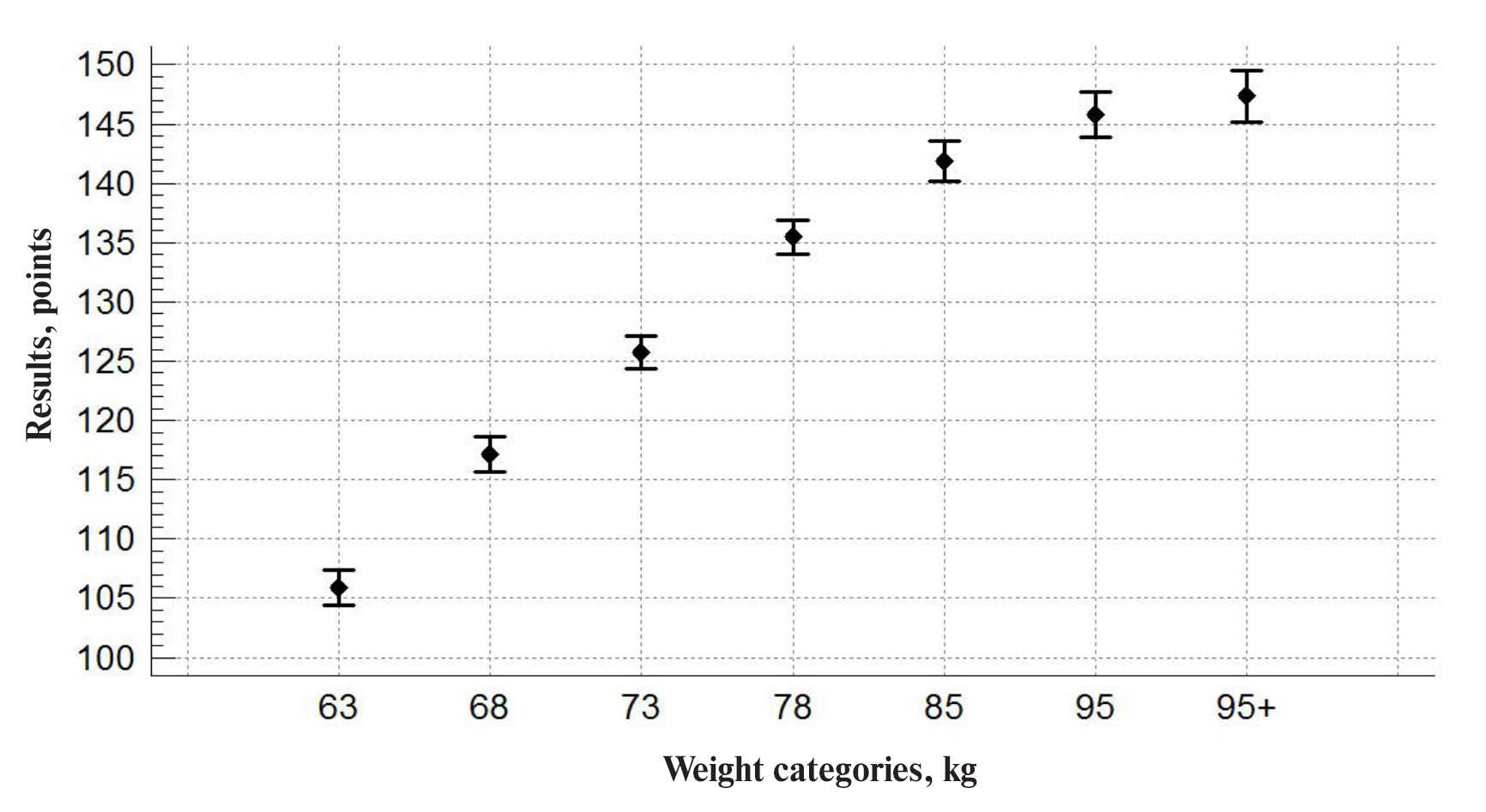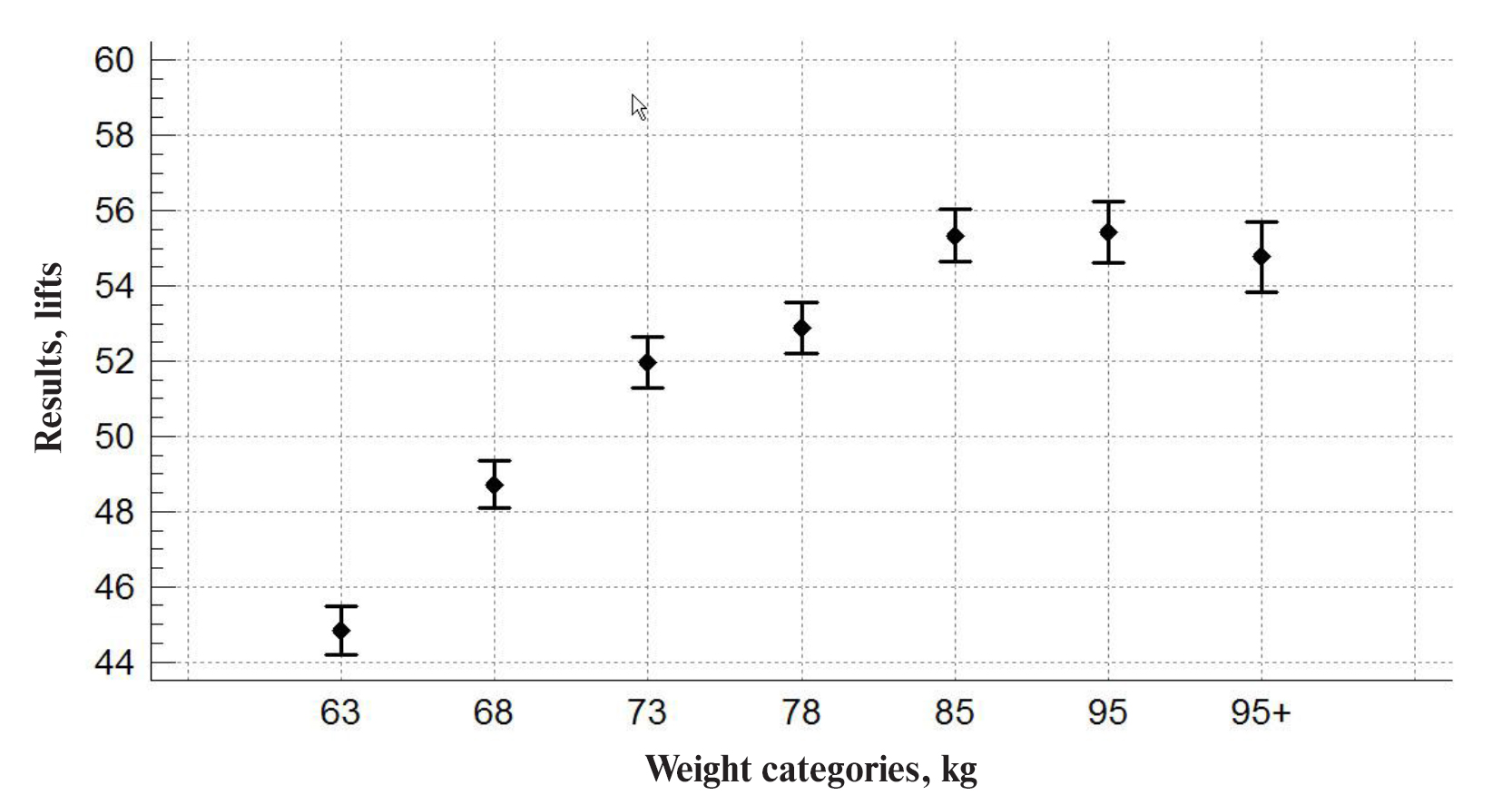Body weight versus competitive performance correlation in kettlebell lifting
Фотографии:
ˑ:
Professor, PhD L.L. Tsypin
Associate Professor, PhD I.E. Barnikova
Professor, Dr.Hab. A.V. Samsonova
Professor, Dr.Hab. G.P. Vinogradov
Lesgaft National State University of Physical Education, Sport and Health, St. Petersburg
Keywords: kettlebell lifting, weight categories, statistical analysis of competitive performance results.
Background. The kettlebell lifting sport is widely acknowledged and popular nowadays both in our country and abroad. The International Union of Kettlebell Lifting (IUKL) includes 50 nations representing virtually every continent of the world. The athletic training methodologies – which at the initial stages of the sport history were largely limited to the strength developing practices at sacrifice of strength endurance that is a very important quality for kettlebell lifters – have been persistently improved lately [2], with the popularity and entertainment aspects of the events being on the rise too. All these and other developments in the sport have been largely addressed by the rules of competitions, including the revisions of the athletic body weight categories. Prior to 1988, the competitions were designed for five weight categories; in 1989 they were expanded to six; and since 1996, the competitions are run in seven body weight categories [4]. As things now stand in the sport, the rules of competitions set the weight categories of up to 63 kg, 68 kg, 73 kg, 78 kg, 85 kg, 95 kg and 95+kg for men (for the 32 kg kettlebell); and up to 58 kg, 63 kg, 68 kg and 68+ kg (for the 24 kg kettlebell) for women.
The modern developments in the sport with further improvements in the athletic training methods and practices have surfaced a few controversial issues including the numbers and limits of the body weight categories in modern competitive kettlebell lifting. Leading specialists are of different opinions on this issue. V.S. Rasskazov, for instance (who has long been chairing the All-Russian Kettlebell Lifting Federation and later on the International Kettlebell Lifting Federation) believes that weight categories in competitive kettlebell lifting does not play such a high role any more as it was the case some 30-40 years ago. Gaps in the technical accomplishments of the lightweight and heavyweight athletes tend to shrink with time. Moreover, it is no more unusual that the actual competitive results in the lightweight categories are higher than in the heavyweight ones.
Our analysis of the national and foreign special literature on the subject has shown that there is only one study report by M.V. Starodubtsev (of 1984) that gives some theoretic substantiations for the recommended number and limits of the body weight categories in competitive kettlebell lifting [3]. This study was based on the results of the April 1983 All-USSR competitions in Klaipeda. However, more than 30 years have passed since then, and the competitive results in the modern sport are largely different today. In addition to classical biathlon, athletes now compete in long jerk. It should also be mentioned that the M.V. Starodubtsev’s study was based on a limited sample of only 95 competitive results for the snatch of two kettlebells.
Objective of the study was to find correlations in the competitive performance results versus the body weights of the kettlebell lifters and use them to offer new body weight categories for the kettlebell lifting sport.
Methods and structure of the study. Subject to the study and analysis were the competitive performance data of the kettlebell lifters having Class I plus qualifications for 32 kg kettlebell lifting classical biathlon and long jerk for the period of 2010 through 2016, as provided by the records of the All-Russian championships, European and Asian Russian championships, Armed Forces of the Russian Federation championships, Regional Russian championships, Russian Junior competitions, Russian Cup competitions, and the Kaluga Province Governor-supported championships. Overall, more than 6300 competitive performance results were obtained and processed under the study [1].
Study results and discussion. Given on Figure 1 hereunder are the kettlebell lifters’ average competitive performance results in classical biathlon for every body weight category, plus standard errors of the average results.

Figure 1. Average competitive performance results of the national kettlebell lifters in the classic biathlon competitions, by weight categories
The above Figure 1 shows that the competitive results tend to grow with the athletes’ body weights, albeit the growth is obviously uneven, with the gap in the results actually shrinking with the body weight rising from the lightweight categories to the heavyweight ones. The gap between the average results in the weight categories of 63 kg vs. 68 kg, for instance, makes up 11.3 points as compared to only 6.4 points for the 78 kg vs. 85 kg. Our statistical analysis of the sample of 3990 competitive results showed their differences for the weight categories of 85 kg vs. 95 kg and 95 kg vs. 95+kg being statistically insignificant (p> 0.05).
Given on Figure 2 hereunder are the kettlebell lifters’ average competitive performance results in long jerk.

Figure 2. Average competitive performance results of the national kettlebell lifters in long jerk, by weight categories
Much like in classical biathlon, the long jerk results tend to grow with the body weight of the competitors, although they actually grow for the weight categories under 85 kg and show no progress for the heavier body weights. This funding supports the conclusion of V.S Rasskazov as to the correlation of the competitive performance results in the middleweight versus the heavyweight categories. It should be noted that the gaps in the results tend to shrink with the athletes’ body weights growing from the lightweight to the heavyweight categories. The difference in the competitive results for the 63 kg vs. 68 kg body weight categories makes up 3.9 lifts as compared to 2.4 lifts for the 78 kg vs. 85 kg weight categories. Our statistical analysis of the sample of 2359 competitive performance results found their differences in the weight categories of 73 kg vs. 78 kg, 85 kg vs. 95 kg and 95 kg vs. 95+kg being statistically insignificant (p> 0.05).
The insignificant differences of the competitive results in the close body weight categories, as found by the study, show the need for the limits of the body weight categories being revised for the benefit of the sport. Therefore, we would offer the following new body weight categories: up to 63 kg, 68 kg, 78 kg and 78+kg. These new categories may be beneficial in the sense that the actual competitive performance results in long jerk are significantly different for every pair of the close weight categories, and the differences are fairly even. In addition, the limits of the proposed new body weight categories are close to the valid ones.
Conclusion. The statistical analysis of the quite voluminous data sample gave us the means to find correlations of the kettlebell lifters’ body weights versus their competitive performance results and use these findings to offer an optimized version of the new body weight categories for the sport. The study data may be helpful as a reference base for the sport specialists in their efforts to improve the athletic training systems and the rules of competitions.
The study was performed pursuant to the State Order from P.F. Lesgaft National State University (Saint Petersburg) for the Research Work “Performance efficiency improvement for the special strength advancement exercises in the elite athletes’ training systems applicable in cyclic sports and competitive martial arts, based on the biomechanical data analysis of the motor action stereotypes and elements in competitive exercises” (Registration Number NIOKTR АААА-А16-116051110019-0, Registration Date 11.05.2016).
References
- Protokoly sorevnovaniy / Sayt Vserossiyskoy federatsii girevogo sporta (Competition Protocols / The site of the Russian Federation of Kettlebell Lifting. [Electronic resource]. – Available at: http://www.vfgs.ru/ protocols (date of access 10.08.2016).
- Rasskazov V.S. Puti i perspektivy razvitiya girevogo sporta (Trends and prospects of development of kettlebell lifting) / V.S. Rasskazov. – Lipetsk: International Federation of Kettlebell Lifting, 2004. – 33 p.
- Starodubtsev M.V. Metodologicheskie podkhody k razrabotke edinykh pravil sorevnovaniy i razryadnykh norm v girevom sporte (Methodological approaches to development of common competition rules and category standards in kettlebell lifting) / M.V. Starodubtsev // Weightlifting: Yearbook. – Moscow, 1984. – P. 73-77.
- Tikhonov V.F. Osnovy girevogo sporta (Basics of Kettlebell Lifting) / V.F. Tikhonov, A.V. Sukhovey, D.V. Leonov. – Moscow: Sovetskiy sport, 2009. – 132 p.
Corresponding author: l_tsipin@mail.ru
Abstract. Objective of the study was to substantiate proposed new body weight categories in competitive kettlebell lifting based on a statistical analysis of the men’s competitive performance results in the top-ranking Russian competitions. Subject to processing and analysis under the study were more than 6300 competitive results in classical biathlon and 32 kg long jerks for the period of 2010 through 2016, for the competitions of athletes having Class I and higher qualifications. Analysis under the study showed the results growing trend with the rising body weight of the athletes. Differences of the results were found to reduce with the body weight rising from the lightweight to the heavyweight categories. The results showed no significant differences in the close weight categories of 85 kg vs. 95 kg and 95 kg vs. 95+kg for classical biathlon; and in the weight categories of 73 kg vs. 78 kg, 85 kg vs. 95 kg and 95 kg vs. 95+kg and for long jerk. Based on the study data and analyses, the following new body weight categories were offered for the benefit of the sport: up to 63 kg, 68 kg, 78 kg and 78+kg. Actual competitive performance results for the proposed weight categories, as found by the study, show significant differences, the differences being virtually the same, whilst the limits of the newly proposed weight categories are fairly close to the valid ones.




